Résumé |
Remarks |
>Top 0. Introduction:
- New field of astrobiology; who peer ever outward into the universe; discovered at least one other Earth-like planet;
- What is an Earth-like planet?; our current atmosphere is but a slice of a forever-changing entity and is greatly different from the atmosphere at most times in Earth's history.
- It is currently suited tu us mammals.
- For most of our history were the size of rats sluggishly gasping in a low-oxygen world as we avoided the active dinosaurian overlords.
- the level of oxygen influenced every large scale evolutionary adaptation or innovation.
- There are four important questions in the study of any history: What? When? How? Why?
- What happened? actual occurrences in the fossil or genetic record.
- When; chronology that binds together the events of history into a linear succession
- How is often deeper; actual mechanism or motive that drove the historical record.
- Why; is the most difficult question to answer and is the subject of endless debate and revision for good reason. it is often the most interesting.
- Critical role of changes in atmospheric oxygen levels on the history of animal life on Earth and why there were dinosaurs and why there are birds.
|
0. 序文:
- 歴史を学ぶ上での4つの疑問:
- What: 何がおきたのか
- When: その時系列は
- How: 実際のメカニズムや動機
- Why: 最も難しい質問で最も面白い
- 参考書: "Wonderful Life"
|
>Top 1. Respiration and the body plans of animal life:
- C. Linnaeus: taxa of hierarchical system:
- Domain; Kingdom; Phylum; Class; Order; Family; Genus; Species
- Species; has an objective definition (interbreeding)
- Phylum; shares a distinct suite of characters of body plan; E.g. vertebrates
- 32 distinct kinds of body plans among animals; formalized later as 37 animal phyla.
- Arthropods: with a jointed exoskeleton;
- Annelid
- Cnidaria: with two cell layers and tentacles with stinging cells called nematocysts
- Mollusks; with soft body but a hard calcium carbonate shell.
- Why did animals evolve the respective body plans seen today?
- answers lie in adaptations to conditions on Earth, about 600 ma
- it was a world different; more oceans and less land, higher temperature, more ultraviolet, more carbon dioxide and less oxygen.
- no large predators or herbivores; competition were only from their own kind.
- the number of phyla; why not 50 or 100 or just one? Why not animals with wheels?
- Phyla first originated as bottom dwelling marine organisms
- the choices decrease as life increases in size and complexity.
- an organism that move requires 10 times more energy than a stationary organism.
- Periodic table:
- H-F: fluorine has a huge disadvantage for life; it explodes when it comes into contact with organic molecules.
- H-OH: the next best is oxygen; aerobic metabolism; requires oxygen to burn sugar into energy.
- more than 200 enzymes are known that require oxygen as part of their synthesis.
- molecules that require oxygen include sterols, some fatty acids, and blood pigments necessary for respiration and synthesis of mineral skeletons (shell or bone)
- ATP (Adenosine TriPhosphate) to ADP (Adenosine DiPhospate) >Top
- there is no life on earth without ATP. ATP is made by bonding the phosphorous atom back on to ADP; oxidation-reduction reaction
- an animal that burns glucose by suing oxygen makes more ATP per unit of time that does a bacterium using fermentation.
- Hemoglobin; Fe containing pigment found in many phyla, including vertebrae, echinoderms, flatworms, mollusks, insects, crustaceans, annelids, nematodes, and ciliates.
- Hemocyanin; Cu containing pigment in gastropods, crustaceans, cephalopods, and chelicerates
- Hemerythrin; Fe containing pigment in sipunculans, polychaetes, and priapulans.
- These pigments bind oxygen more strongly when oxygen is high (in lungs or gills, or alkaline pH) and release it when low (in respiring tissues, or acid pH)
- Oxygen free zones:;
- blackness of subterranean world is a reducing environment as contrasted to an oxidizing one.
- lack of oxygen precludes animal life
- Gulf of Mexico, and Black Sea; animals are rare or absent at anoxic world.
- Thermohaline circulation system; >Top where cold, salt-rich, highly oxygenated bottom water is moved through the deeper oceans beneath warmer, fresher water masses.
- But during past times of warmer climates, when there was much less of a heat gradient, the oceans were stratified, just as the Black Sea; oxygenated surface region atop with anoxic ocean at depth.
- Oxygen in water and air:
- Water is only about 7 ml of O2 per litter of water; temperature of water plays a major role.
- Both O2 and CO2 are larger than H2O molecule; any membrane that allows these gases to diffuse across it will also leak water.
- animals in dryer environments, some kind of impermeable body coating is needed to halt desiccation, but there have to be places where gas can come in as well.
- 5 factors control diffusion:
- solubility of the gas
- temperature at which the animal lives
- surface area available for gas exchange
- difference in partial pressure of gases
- thickness of the barrier
- Drowning victims die not from death of muscle or fat but from nerve cells.
- nerve cells need for an efficient source of delivering oxygen.
- Gills (evaginations) used in water and lungs (invaginations) used in air.
- no animal has ever evolved an organ that could work both in air and water.
- Passive gill; depends on contact with the medium to bring necessary oxygen.
- gills only work if there is a thin barrier between the water and the animal's blood; thus gills cannot be armored.
- mollusks, arthropods enclosed their gills; but reduces respiratory efficiency.
- position itself in high current areas.
- Active gill:
- maximize the flows of water across the gill through active pumping; by evolution of cilia or flagella.
- Countercurrent flows: fish gills; the blood being pumped across these gills has just come back from the body, and it is rich in CO2 ions. Wen this bicarbonate-rich blood reaches the gills (or lung) the bicarbonate is transformed back to CO2.
- Pumping mechanism; use a series of muscles, diaphragm to inflate our lungs
- Lungs: air is far less dense than water; an equal volume of air contains many thousand times fewer molecules of oxygen.
- animal uses to pump air into the lung chamber; breathing
- Purpose of respiration:
- used exclusively for O2 acquisition and CO2 excretion; typical of vertebrates.
- but respiratory structures often double as feeding organs in many invertebrates.
- late Paleozoic was a time of rapidly falling oxygen; blamed for the great Permian extinction.
- respiratory changes usually require the most extensive morphological transformations. (E.g.: Lystrosaurus; 254-248 ma)
- Efficiency of lungs:
- Bird is at least 33% more efficient than any mammal lung.
- Vicuna and Alpaca in South American mammals are among the best.
-
|
1. 動物の呼吸と身体の設計
- リンネの分類:
- ドメイン; 界; 門; 綱; 目; 科; 属; 種
- 刺胞動物
- 真核生物; 動物界; 脊椎動物門; 哺乳類綱; サル目; ヒト科; ヒト属 homo; H. Sapiens
- Sterol:
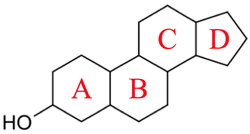  - Hemoglobin:
- 脊椎動物; 棘皮動物; 扁形動物; 軟体動物; 昆虫; 甲殻類; 環形動物; 線虫; 繊毛虫
- Hemocyanin:
- Hemerythrin:
- ATP/ADP
- 富栄養化:
- 熱塩循環:
- 分子の大きさ:
- N2: 0.364 nm
- O2: 0.346 nm
- CO2: 0.33 nm
- H2O: 0.28 nm - (0.38)
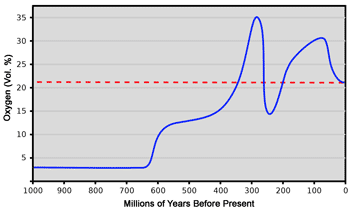
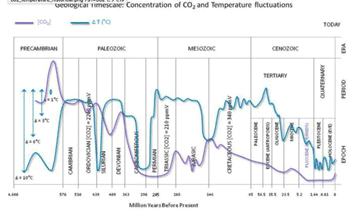
- Lystrosaurus:
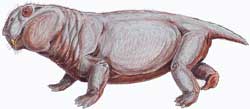 - 肺:空気は水より希薄。酸素分子は数千倍に希薄。
- 呼吸の目的: 酸素吸入とCO2排出
- 呼吸と食道との共用
- 横隔膜
|
>Top 2. Oxygen through time:
- Atypical of Earth:
- We live today in a world that is quit a typical of Earth over 4.6B years long history.
- The atmosphere has changed over time; only 5 ma, oxygen levels were significantly higher than now, while less than 100 ma, oxygen levels were significantly lower than today.
- Present earth: N2 78%, O2 21%, Others 1%:
- CO2 and H2O are within 1%.; greenhouse effect.
- Composition of volcano effluents; H2O 50-60%, CO2 24%, S 13%, N2 6%; differs markedly from the current atmosphere.
- Outer planets and moons from Jupiter outward are rich in water.
- Water was brought her from the outer reaches of the solar system by comets impacting the planet early in its history.
- 4.2 -3.8 ba, known as the Heavy Bombardment period.
- little or no oxygen; CO2 was 10000 times higher than today.
- cyanobacteria widespread in the oceans; most of oxygen came from photosynthesis by single celled bacteria about 3.5 ba.
- larger plant cells took place perhaps 2.7 ba and by 2.3 ba a build up oxygen in the atmosphere was taking place.
- ozone layer thick enough to shield life on the surface from harmful ultraviolet radiation.
- Sulphur cycle:
- Sulphur is added from rivers as it weathers out of pyrite bearing rocks or sulfur rich sedimentary rocks (gypsum and anhydrite)
- this pyrite is heated; emitted hydrogen sulfide and sulfur dioxide
- Carbon cycle:
- large quantities of reduced carbon compounds, such as animal and plant bodies after death; quickly buried has a major effect on oxygen levels.
- sedimentary uranium minerals in river deposits of more than 3 ba; covered with an oxygen-free atmosphere.
- GEOCARBSULF:
- forcing processes that affect the oxygen level.
- rate of metamorphic and volcanic degassing of reduced carbon- and sulfur-containing gases.
- rate of mountain uplift
- rate of sea level change
- burial of organic matter
- colonization of land by plants
- burial rate of reduced carbon and pyrite sulfur were enhanced or inhibited.
- Solar energy: 4.4% increase since earliest Cambrian
- Geological time:
- Animals first appeared: about 540 ma (million years ago9
- Cambrian-Ordovician (500 ma): 15% O2
- middle of Permian (250 ma): greater drop (35%→15%)
- Evolution and Oxygen:
- What determined the body plans; fossil record and on Earth today.
- increasing temperature or pH or salinity
- Cambrian Explosion:
- not only physical and biological characteristics, but to those environments.
- Evolution of animals; by two different effect: 1) modernization, 2) in response to environmental change.
- more shell defense in the prey organisms
- changing oxygen levels
- Snowball Earth; episodes of 2,700 ma and 600 ma
- Changing atmospheric oxygen levels over the last 600 m years cause significant evolutionary changes in animals.
- Three times of greater and lesser evolutionary changes; to form new species and changes in body plan.
- Cambrian Explosion:
- was a time with high levels of carbon dioxide.
- high carbon dioxide data showed high rates of new species formation.
- macroevolution is directly affected by carbon dioxide levels.
- CO2; biological neutral to animal life; certainly affected plant life, stimulates more growth.
- Greenhouse gas; temperature change has been the most important factor.
- high temperature increase marine diversifications; low temperature or glaciations inhibit marine diversification.
- increase seafloor spreading rated that could encourage biological diversification.
- past 400m years; periods with high CO2 were times of low O2 and the reverse was true as well.
- High significant correlation: it is not high CO2 (=warm temperature) that stimulated high speciation rate, but low O2.
- 15% O2 stimulated new speciation rates, in response to animal attempting to cope with a reduction of O2 in the early Paleozoic.
- morphological adaptation that appear to be related to O2 levels, by maximize respiratory efficiency.
- Theory of Punctuated Equilibrium; most morphological changes occur during speciation events; when a new species forms, not gradually.
- the changes necessary to adapt to low O2 levels (<15%)
- The Big Five:
- 1) O-S, 2) Late D, 3) P-Tr, 4) Tr-J, 5) K-Pg
- mass extinction of more than half the world's fossils; biotic crisis.
- the case of Ordovician, Devonian, and Triassic mass extinctions happed after 10% drop in O2.
|
2. 酸素の時代変遷:
- hypoxia: 低酸素症
- anoxia: 無酸素症
- Ceres; more water than Earth.
- Component of dry air:
- N2: 78.08%
- O2: 20.95%
- Ar: 0.93%
- CO2: 0.03%
- Geologic time scale:
| Eon |
Era |
Preiod |
| -0.012 |
Cenozoic |
Quarternary (Holocene) |
| -2.58 |
Quarternary
(Paleocene) |
| -23 |
Tertiary (Neogene) |
| -66 |
Tertiary
(Paleogene) |
| -145 |
Mesozoic |
★Cretaceous |
| -199 |
Jurassic |
| -252 |
★Triassic |
| -299 |
Paleozoic |
★Permian |
| -323 |
Carboniferous (Pennsylvanin) |
| -359 |
Carboniferous
(Mississippian) |
| -419 |
★Devonian |
| -444 |
Silurian |
| -485 |
★Ordovician |
| -541 |
Cambrian |
| Eon |
|
| -1000 |
(Neo) Proterozoic |
| -2500 |
(Paleo)
Proterozoic |
| -4100 |
Archean |
| -4500 |
Hadean |
| |
|
|
- 進化と酸素濃度
- 体型の設計
- カンブリア爆発
- 動物の進化
- 雪だるま地球
- 酸素レベル
- カンブリア爆発
- CO2高濃度・O2低濃度時代
- 温室ガス効果
- O2濃度15%
- a
- 断続平衡説: 生物種の変化が急変化する時期とあまり変化しない時期がある。(ダーウィン的な漸進的な進化はしない。)
- The Big Five: OLPTK
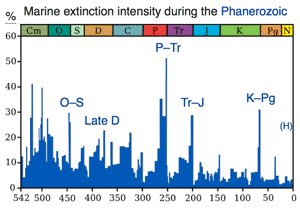
|
>Top 3. Evolving respiratory systems as a cause of the Cambrian Explosion:
- All paleontological mysteries: what caused the rapid diversification of animal body plans in the Cambrian Explosion?
- Animal life on Earth: 550 ma; Cambrian Period is dated 544 -495 ma.
- Start of Cambrian Period: O2 level 13% and tens time higher CO2
- 522 ma: so little vegetation, almost bare rock. Plant life is limited to moss, photosynthesizing bacteria.; the Burgess Shales was deposited some 510 ma.
- Mt. Everest in terms of O2, but seashore in terms of air pressure; this is not thin air, but low O2 air.
- Sand is composed of minerals, no flaked of seashells or bits of coral.
- Big tidal change; at least 15m; the moon is clearly closer to Earth.
- Céngjiāng:
- a window to a floor lower than that of the Burgess Shales, 12 m years separating, including preservation of soft parts.
- arthropods were the most successful of Cambrian animals.
- The Origin of Phyla by James Valentine:
- The segmented nature of the arthropod body is related to the machines of body movement, particularly to locomotion, with nerve and blood supplies in support.
- the formation of a large gill surface area, with the gnathobase water current system evolving as part of this respiratory structure.
- Oxygen acquisition purpose primarily led to this body plan.
- Trilobites turn out to have a very high gill to body volume ration.
- brachiopod: combination of feeding and respiration in the same design.
- HAM (Hypothetical Ancestral Mollusk) model:
- The creature is cephalized with a distinct head; broad foot, internal viscera, and capping dorsal shell.
- respiration is through the paid gills, at the back of the animal.
- The earliest do not resemble HAM in many ways.
- Earliest mollusks have been designed with multiple sets of gills, necessary in a low O2 world.
- Reduction is seen in the number of paired gills, with ancestral gastropods and bivalves reducing the number of gills to a single pair; occurred during the Cambrian.
- Shell-pump:
- Shells became part of the respiration organ in creating enclosed spaces for pressure water to flow over the gills; also functioned to take out fecal and waster material at the same time.
- Cambrian Mollusk discovered:
- Evolving a body plan that could move fast despite the scarcity of O2.
- Cephalopods evolution:
- Propulsion system; as an offshoot of the respiration system. The design allows a dual function - respiration and locomotion - from the same energy expended to draw water in and then force it out.
- Eventually most lost ¥their shells, but the respiratory system of the cephalopods remains supreme and will ensure their existence far into the future.
- Larva stage:
- Paedomorphism: their larva strongly resemble small fish;
- Urochordate:
- our nearest nonchordate ancestor
- split of the tunicate group into tunicates and vertebrates probably occurred in the latest pre-Cambrian; evolved in response to low O2 by producing a body plan with a highly powerful and efficient pump gill.
- their gill system seems to be a case of overkill - there is far more potential than need. If ever there was a design that can handle very low oxygen, this is sit.
- the pump may have evolved to capture food when the body was small enough to respire more passively, rather than for respiration.
- End of Cambrian:
- there in not a Burgess Shale-like deposit in the earliest Ordovician rocks.
- end-Cambrian event was every bit as destructive as any of the Big Five.
- the extinction appears to coincide with a rapid drop in O2.
- sudden drops in O2 were mass extinction instigators.; but the extinction was also an instigator of future diversity.
- the survivors were more efficient respirers than those that died out.
|
3. 呼吸システムの進化とカンブリア爆発:
- カンブリア爆発による体型の多様化
- 地球上の動物の歴史: 550ma
- カンブリア紀 544-495 ma
- O2レベル13%、Co2レベル2倍
- 澄江動物群: バージェス頁岩の時代より12m年不売り
- 門の起源 (James Valentine):
- HAM:
- カンブリア紀の終焉:
- オルドビス紀には、バージェス頁岩型の動物はいない。
- オルドビス紀はBig Five中最大の大量絶滅の後形勢された。
- 大量絶滅はO2濃度の急激な低下が関係。
- 大量絶命はまた新たな多様化の始まり
- 生き延びた生物は例外なく、効率的な呼吸システムを持つ。
|
>Top 4. The Ordovician: Cambrian Explosion Part II:
- Land surface of Ordovician:
- no trees or even rooted plants; but mosses have spread and are primitive vascular plants.
- invasion has started; occasional movement of animals; scorpion and centipede-like arthropods.
- no fish; but plenty of trilobites and other arthropods.
- Ordovician Period can be regarded as the second half of the two part initiation of animal diversity on Earth.
- huge increase in the number of animal species in the sea.
- Ordovician was a time of much larger animals, compared to Cambrian-aged members.
- In the brackish water:
- ostracoderm: (>fig.)
- Skeletal building works better in air or water that is rich in O2 and nutrients.
- but Ordovician was still lower O2 level than today.
|
4. オルドビス紀: カンブリア爆発II:
- Ostracoderms:
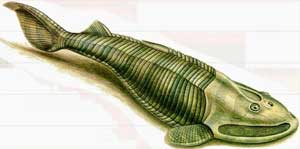 |
>Top 5. The Silurian-Devonian; How an oxygen spike allowed the first conquest of land:
- Silurian (443-416 ma) and Devonian (416-359 ma)
- Invasion of the land: greening; plants for the first time rose up from the soil to point green leaves at an enlarging sun..
- From middle of Ordovician until end of Silurian (60m ) O2 uninterruptedly rose 10%; from 15% to 25% of the air.
- a small diversity of insects; springtails; no land-dwelling vertebrates of any kind.
- fish with jaws heavily armored.
- Eurypterids, 3m long: amount of O2 is often a determinant of its final size.
- Large size lends protection against predation (Cope's Rule)
- Evolutionary advantages in arthropods, mollusks, annelids, and eventually vertebrates had finally arrived to climb out from water to the land.
- Plant evolution: in CO2 acquisition, nutrient acquisition, body support, and reproduction.
- Green algal group, like Charophyceae, photosynthetic land plant:
- problem of desiccation; having a resistant cuticle; stomata evolved as tiny portals for gaseous CO2.
- evolution of stems; transport system from newly evolved roots up to newly evolved leaves.
- all living things require liquid within them.
- The conquest of land by vertebrate groups was enable by a rise in O2 levels during Silurian Period.
- Had atmospheric O2 levels not risen, animals might never have colonized land.
- Colonization of land by animals(arthropods and vertebrates) took place in two waves (430-410 ma) and (370 ma onward)
- Amphibians:
- are the vertebrate group first colonized the land
- crucial transition from a fish with lobe fins and gills to an animal with for legs.
- could they breath in air without the help of water-breasthing gills as well?
- the first tetrapod bone fossils are not known until their appearance in 360m ago.
- the time of lowering O2 stimulate the most consequential evolution; the formation of new body plans.
- fish and amphibians diverged; 450 ma by molecular clock.
- Romer's Gap:
- Devonian mass extinction.
- colonization of the land came in two steps; 410-400 ma and 330-300 ma
- Romer's Gap ended in the Carboniferous Period (Mississippian and Pennsylvanian Period in US); O2 level nearly 35%, creating unique interval in Earth's history.
- Insect system:
- There is little or no pumping lung system
- Springtails are insects, presumably the most ancient animal group on Earth today.
- Insects remained and marginal member of the land fauna until nearly the end of the Mississippian Period (330 ma)
- Scorpions; in mid-Silurian time (430 ma); crawled out of the water and move about on land.
- End of Silurian; was a time when O2 had already reached very high levels. (410 ma)
|
5. シルル紀・デボン紀: 酸素濃度急上昇と最初の陸上進出:
- シルル紀とデボン紀
- 節足動物、軟体動物、環形動物、脊椎動物の陸上への進出
- 植物の進化: CO2と栄養摂取、身体の支え、葉への進化
- O2レベルの上昇
|
>Top 6. The Carboniferous-Early Permian: High oxygen, fires, and giants
- Large size:
- is often a protection against predation; most animals grow as large as they can.
- 90cm long scorpion could weigh 23 kg and wold be a formidable predator of all land animals.
- But there are costs to this; one of the most stringent is the new, bigger body receives sufficient oxygenation.
- chitin; making up the arthropod exoskeleton; not insect is bigger than about 15cm; a giant ant's ledge snapping.
- arthropod respiration; O2 can diffuse into the inner most regions of their bodies.
- It is the respiratory system that dictates maximum size.
- O2 reached high level: 320-260 ma
- sky is polluted yellow-brown, irrespective of weather; due to smoke from giant fires perpetually raging.
- O2 partial pressures rose, and the total gas pressure was higher than today.
- due to burial of large volume of carbon and pyrite; burial of photo- and zooplankton, too.
- Either side of big continent has long chain mountains, which produced wet climate.
- giant amphibians; some 3m long
- insects promotes larger size at higher O2.
- yard-long dragonflies; 30 inch (76 cm) wingspan is known.
- flowers will not appear for anther 200m years.
- A great deal of organic matter is buried, O2 levels go up; 35% (highest levels of all times in late Carboniferous or early Permian)
- 90% of coal deposits are found in the rocks of 330-260 ma.
- Carboniferous Period was the time of forest burial on a spectacular scale (600 times higher)
- phytol- and zooplankton; organic rich sediments accumulated on sea bottoms.
- there are more toxic hydroxyl radicals that are dangerous to living cells.
- Evolution and diversity:
- Low O2 stimulated new kinds of evolution but were also times of low diversity.
- Low O2 forces new experimentation in terms of body plan.
- Hypothesis: during high O2 times, conversely, diversity is high but the rate of new species formation is low.
- This proposal is supported by a new comparison of oxygen levels with data on the rat of new taxon formation.
- very low rate of new species formation during O2 high of Carboniferous - early Permian.
- Before the end of the Mississippian Period; reptiles had diverted from one another to become 1) mammals, 2) turtles, and 3) birds
- Amniotic eggs:
- Tetrapods: embryos were not born until substantial development within the female had taken place.
- Moisture must be conserved, so the openings of the egg must be few and small.
- The first amniotic eggs were probably produced in O2 levels equal or even higher than of today.
- the placenta delivers lower levels of O2 than are present even in arterial blood in the same mother.
- But reptiles have a very different: low O2 even favors live birth.
- the highest nests: low O2, desiccation, low temperature
- leathery, or parchment, eggs compared to calcareous eggs.
- Body plan of the earliest land terapods:
- each breath must be taken between steps; makes it impossible for the animal to take a breath when running; there are no reptilian marathoners and not too many long-distance sprinters.; this is why reptiles and amphibians are ambush predators.
- early amphibians and reptiles evolved a three-chambered heart; inferior respiration while moving.
- moving their legs under the trunk of the body; greatly decreased the lung compression that accompanies the sinuous gait.
- O2 and land animals:
- the evolution of amniotic egg differentiates reptiles, birds and mammals from amphibians.
- end of Mississippian Period: one that gave rise to mammals, a second to turtles, and a third to birds.
- Definition of reptiles:
- reptiles can be defined by what they are not: lack specialized characters of birds and mammals.
- Trade-off of an egg:
- Moisture must be conserved, so the openings of the egg must be few and small.
- but reducing permeability of the egg to water moving from inside to outside also reduces the movement of O2 into the egg by diffusion.
- High O2 may have allowed amniotic eggs and then live birth.
- birds living in high-altitude habitats routinely feed at higher altitudes; the highest nests are at 5,500m, and higher than this the embryos will not develop successfully; lower O2, desiccation, low temperature.
- Increased O2 clearly influences growth rates, at least in American alligators.
- Embryos developed by the live birth method are not endangered by temperature change, desiccation, or O2 deprivation. but the cost is added volume to the mother; make her need more food than would be necessary for herself alone.
- Endothertmy or ectothermy:
- Warm-bloodedness (endothermy) allows animals using it to stay at a constant, warm temperature not matter how cold it gets.
- Cold-blooded animals match the temperature around them.
- a third kind of metabolism; found in animals so big that they are largely unaffected by daily swings in temperature; very large dinosaurs presumably used this system.
- Reptiles and their size:
- O2 level over 30% in Caboniferous-early Permian: accompanied by the evolution of insects of unprecedented size.
- High oxygen would have enabled insects to grow larger,
- giant dragonflies and others of the late Carboniferous through the early Permian were the largest insects in Earth's history.
- Therapsids of the Triassic are much smaller than those of the Permian.
- The drop in size of Triassic forms compared to their Permian ancestors. There is a strong correlation between terrestrial animal size and oxygen levels.
|
6. 石炭紀・初期二畳紀: 高濃度酸素、火災、巨大化:
- 進化と多様性
- 低酸素は新種類の進化を促進するが多様性はない。
- 反面、高酸素時代は多様性は高いが、新種の登場は低い。
- 石炭紀前期は、爬虫類から1) 哺乳類, 2) カメ類, 3) 鳥類が分岐
- 羊水中の卵
- おそらくO2高濃度時代に登場。
- 爬虫類はO2低濃度を好む。
- 初期陸上四肢動物:
- 呼吸はステップの間のみ。走行中の呼吸は不能。捕食は待ち伏せのみ。
- 初期の両生類と爬虫類は2心房1心室
- 四肢は体の下側に移動し、肺への圧迫を減らす
- O2と陸生動物
- 石炭紀後期: 一部は哺乳類は、二部はカメに、三部は鳥類に進化
- 卵のトレードオフ
- 湿気保存の必要性
- 透水性が増すとO2透過も減少。
- O2高濃度環境は
- 5000m高度地域に棲む鳥類; 低酸素、乾燥、低温に適応
- 子供が大きくまで育つと温度・乾燥・低酸素に対応できるが母体への負担も増加
- 常温動物と変温動物
- 常温動物は外気温に関わらず
- 変温動物は外気と温度が一致する
- 第三種の方法: 極めて巨大化した恐竜
- 爬虫類とそのサイズ:
- トンボ等昆虫の巨大化
- 三畳紀の獣弓類は、二畳紀の同種に比べて小型化
|
>Top 7. The Permian extinction and the evolution of endothermy:
- Permian extinction; The Great Dying, The Mother of All Extinctions, The Day that Life Almost Died.
- 251 ma; end of Permian.
- terrestrial world: they are stolid and lamb-sized; the largest motionless animals.
- low O2 quickly puts them in respiratory debt: the lack of diversity is the most striking aspect of this world.
- Even insects are rare of few varieties, for their kind suffered great losses in the extinction that by this time.
- the sight of the ocean is a shock; it is not blue, but a deep purple; the surface regions are cloudy with untold number s of purple and green bacteria, presence of toxic gas hydrogen sulfide.
- Oceans and lakes release the surplus hydrogen sulfide gas and thus poison the land organisms.
- there are different kinds of survivors among the fish and cephalopods, but there are o coral reefs, or trilobites; the most striking impression is how few in number the various kinds of life are.
- 270-200 ma: rapid drop in O2 and rapid rise in CO2:
- O2 level: 35% in early Permian, to as low as 12% in early Triassic.
- the new kind of photosynthesis, called C4 pathway, is found in many grasses.
- in Permian; the drop of CO2 greatly affected plant life
- Why did this happen?
- formation of supercontinent Pangea was completed.
- sedimentary basins and swamp uplifted; no longer serve as traps and reservoirs of reduced carbon.
- drastically reduced the amount of plant material;
- The episode at 251 ma:
- mass extinction was caused by a large-body impact with earth?; the presence of Ir levels, grass spherules, and shocked quartz.
- CO2 catastrophe:
- Methane catastrophe.
- Heat spike and low O2 caused by Siberian traps
- Hydrogen sulfide (H2S) poisoning.
- O2 level 12%: the only place on Earth where terrestrial animals could live would be at sea-level. (about 50% of the Permian land surface); H2S releasing bacteria overwhelmed the surface water; (purple ocean)
- New scenario for the Permian Extinction:
- the destroy of ozone shield; exposure to high ultraviolet fluxes; biomass of phytoplankton rapidly decreases.
- First, the removal of species through extinction opens the way for new species to form to fill the suddenly emptied niches. The more catastrophic the extinction, the greater this effect will be.
- Second, if the mass extinction is caused by a long-term environmental change of some sort, species will have an opportunity to try to adapt to the new conditions.
- There is solid evidence that endothermy appeared in the interval of time when O2 was dropping fastest; all consequential changes occurring as well, including the evolution of live birth.
- Endothermy is a characteristic of birds and mammals and is considered an advanced trait.
- when ectoderms are still sluggish from the evening, endoderms are already moving and moving fast - to pray on animal, to avoid predation, to find shelter or mates.
- The chemical reactions that keep any cell alive run at different rates at different temperature
- Why was endothermy evolved and when?:
- Endothermy evolved near end of Permian, as O2 levels were plummeting.
- the first evidence of endothermy comes from a small set of bones in the nasal area called turbinals.
- predation requires more activity than herbivory, needing more O2 than herbivores in an O2-starved world; reducing water loss as they panted their painful way after prey.
- Slow change:
- The drop in O2 at end of Permian was profound but slow.
- Slow change is ideal for evolutionary response to changing and deteriorating environmental conditions; stimulated various reptiles to increase efficiency of O2 uptake through the evolution of endothermy and by changes in the nasal area of the skull.
- The most obvious change would have been in the lungs and circulatory system, and evolution of the four-chambered heart probably happen at this time.
- Four-chambered heart:
- Both avian and mammalian herats have four chambers; two auricles and two ventricles.
- Many other land tetrapod lineages, reptiles and all amphibians use a three-chambered heart.
- In the four-chambered system, there is never mixing of two blood groups (returning to the heart and coming back from the lungs; but in the three-chambered heart, mixing can take place; reducing the efficiency and O2 carrying capacity.
- Also, four-chambered hearts are larger than the hearts of ectotherms, and high blood pressure seems to be associated with endothermy.
- modern crocodiles have four-chambered heats, a trait associated with endothermy
- During times of low O2, altitude creates barriers to migration and gene flow. Low Ow times should have many separate biotic provinces, at least on land. The opposite occurs during high-oxygen times; there will be relatively few biotic providence and a worldwide fauna.
- At end Permian just living at sea level would have been equivalent today to breathing at 4,500 m.
- It made most areas (higher than 900m uninhabitable during late Permian-Trassic time interval. (altitudinal compression); increased competition for space and resources in populated lowlands, causing some number of species to go extinct.
- the fate of plants: a change in the kind of flora during the period and a substantial extinction of plants at the end.
- Results of the Permian Extinction:
- Aftermath of the extinction, ecosystems were profoundly affected, and extinction recovery was long delayed.
- While both caused more than half of the species on Earth to disappear, the world recovered relatively quickly after Cretaceous-Tertiary event. (by a large body impact on Earth)
- Permian extinction persisted for millions of years after the onset of the extinction. It was not until the middle Triassic, 245 ma, that some semblance of recovery seems to have been under way.
- The Triassic was truly the crossroads of animals adapted to two different world, one of higher O2 and one of lower.
|
7. 二畳紀大絶滅と内温動物の進化:
- 二畳紀大絶命の呼称
- 陸上生物:
- O2低濃度は、多様性の希少化
- 昆虫ですら種類減少。
- C4 carbon fixation: C4型光合成;
光合成の過程でCO2還元回路(カルビン回路)の他にCO2濃縮のためのC3経路を持つ。高温・乾燥・低CO2・貧N土壌環境化で進化した。トウモロコシ・サトウキビ・雑穀はC4作物。イネ・小麦はC3作物。
- O2 level:
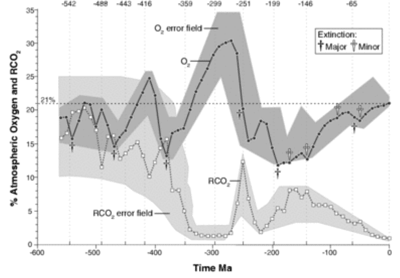
- 大量絶滅(251 ma)のエピソード:
- 隕石衝突説
- CO2激変
- メタン激変
- シベリア
- 変動; 高温化、O2減少
- H2S増加
- 二畳紀絶滅のシナリオ
- オゾン層の破壊
- 一部の生物層の絶滅による新たなニッチ出現
- 大量絶滅は長期に亘る環境変化が原因。
- 常温性は、鳥類と哺乳類のみ
- 変温動物は夕方など動きが鈍い。常温動物はすばやく対応可能
- なぜ常温動物が発生したか。
- 徐々にO2レベルの低下
- 徐々の低下であれば変化・環境悪化への対応可能
- 肺・循環器・2心房2心室心臓
- 2心房2心室:
- 標高・大気密度・気温:
-
| m |
mbar |
ºC |
| 0 |
1013 |
15.0 |
| 500 |
955 |
11.8 |
| 1000 |
999 |
8.5 |
2000 |
795 |
2.0 |
| 3000 |
701 |
-4.5 |
| 4000 |
617 |
-11.0 |
| 4500 |
578 |
-14.2 |
| 5000 |
540 |
-17.5 |
| 6000 |
472 |
-24.0 |
| 7000 |
411 |
-30.5 |
| 8000 |
357 |
-36.9 |
| 9000 |
308 |
-43.4 |
| 10000 |
265 |
-49.9 |
| 12000 |
194 |
-56.5 |
| 15000 |
121 |
-56.5 |
| 17000 |
88 |
-56.5 |
| 20000 |
55 |
-56.5 |
- 二畳紀の低O2時代は、当時の海岸でも現在の標高4500mに匹敵
- 二畳紀の絶滅は数百万年以上も継続。ようやく三畳紀半ば245 maになって回復し始める。:
- 三畳紀は、O2低レベル動物と高レベル動物の交差点。
|
>Top 8. The Triassic explosion:
- Triassic Period: roughly 250-200 ma, an interval 50 my, the first period of Mesozoic Era.
- Both start and end of the period are mass extinction events.
- most interesting assemblage of organisms; creating the largest number of new body plans since the Cambrian.
- the early Triassic world was empty of life.
- Triassic Explosion
- Bivalved mollusks; and diversified ammonoids and nautiloids refilled the oceans.
- many land reptiles returned to the sea.
- therapsids survived the Permian extinction and competed with archosaurs of dominance of the land in early Triassic.
- From mammal-like reptiles to lizards, earliest mammals to true dinosaurs, the Triassic was a huge experiment in animal design.
- Why?:
- the Permian extinction removed so many of the dominant land animals that opened for more innovation.
- Body plans were being stimulated into creation to intense selective pressure; the need to access sufficient oxygen to feed, breed, ad compete in low O2 world.
"Nothing sharing the mind faster than imminent death."
- the diversity of Triassic animal plans is analogous to the diversity of marine body plans in the Cambrian Explosion (followed a mass extinction of Ediacaran fauna.)
- Cinodont:
- The cynodonts are not the only mammal-reptiles, for rhino-sized dicynodonts also browse the low brushy vegetation.
- The carnivores mostly lay in wait, and the herbivores browse stolidly.
- O2 level:
- minimal levels of 10-15% for at least 5m years (245-240 ma)
- animals had a long period of difficult times. But difficult times are what best drive the engines of evolution and innovation and from this trough in oxygen on Earth merged new kinds of animals.
- On land two new groups were to emerge from the wreckage; mammals and dinosaurs, most sorting respiratory systems better able to cope with the extended O2 crisis.
- Inverse correlation between Mesozoic O2 levels and the number of marine reptiles: the number of vertebrates returning to the sea increased during high-temperature, low O2 times. The cooler water would have enhanced survival in a low-O2 world.
- Dinosaur diversity was strongly dependent on O2 levels;
- long period of low dinosaur diversity after their first appearance in Triassic was due to extremely low O2 of late Triassic.
- low O2 times apparently stymied the formation of many individuals (while at the same time stimulating experimentation with new body plans to deal with the bad times.)
- higher O2 supported a higher diversity of dinosaurs. Part of the reason be due to the fact that rising O2 levels opened up more habitable areas at altitude.
- Triassic -Jurassic -Cretaceous:
- Through late Triassic and first half of Jurassic, dinosaur numbers were both stable and low.
- O2 rose in Jurassic, hitting 15% or more in the latter part of Jurassic. It was then that the number of dinosaurs really began to increase. Also at this time that the sizes of dinosaurs increase.
- the largest dinosaurs that ever evolved appearing from late Jurassic through Cretaceous.
- O2 levels steadily climbed through Cretaceous and so too did dinosaur numbers; the true dinosaur heyday.
- it is not until the late Jurassic that dinosaur numbers started to rise significantly; this trend continued inexorably to the end of Cretaceous.
- Triassic -Jurassic Mass Extinction:
- One of the five most deadly mass extinctions of the past 500 m years.
- The groups with the simplest lungs (amphibians and thecodont reptiles) fared the worst.
- Both amphibians and thecodonts probably had very simple lungs inflated by rib musculature only.
- Mammals and advanced therapsids of this time, probably both having diaphragm-inflated lungs, but crocodiles with abdominal pumps, did poorly.
- Air sacs:
The success of saurischians may have been due to t a multitude of factors (food acquisition, temperature tolerance, avoidance of predators, reproductive success); possessing a highly septate lung with air sacs that was more efficient than the lungs of any other lineage; this respiratory system conveyed great competitive advantage.
- Saurischian dinosaurs took over the planet at the end of the Triassic and kept that dominance will into the Jurassic because of superior activity levels, which was related to superior oxygen acquisitions.
- O2 reached its lowest levels of the past 500m years in the late Triassic.
- Hypothesis: Saurischian dinosaurs had a lower extinction rate than any other terrestrial vertebrate group because of a competitively superior respiration system - the first air sac system.
|
8. 三畳紀大爆発:
- O2 levels 16%
- CO2 level 1750 ppm (6 times of pre industrial level)
- surface temperature 17ºC (+3ºC aover modern level)
- 中生代以降のO2濃度:
- O2レベルと海生爬虫類の数とは反比例: 高温・低O2の濃度で増加。
- Diversity of tetrapod genera fro middle of Triassic to Middle of Jurassic; time interval of some 60m years.; Only saurischian dinosaurs increase in diversity leading up to and after Triassic-Jurassic mass extinction. Theri uniqu air sac system may have been the prime reason for this.
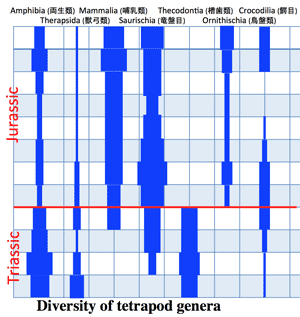
|
>Top 9. The Jurassic; Dinosaur hegemony in a low-oxygen world:
- Jurassic Period: only 50m years after the great paroxysm of the Permian extinction, the Triassic Period came to an end.
- Mass extinction ending the Triassic Period was not just a phenomenon on land; also wiped out in three great lineages; nautiloids, ammonites, and coleoids.
- On land the dinosaurs flourished, and mammals retreated in size and numbers to become a minor aspect of the land fauna.
- Times of innovations:
- Jurassic and the succeeding Cretaceous Period were times of innovations on land, in the sea, and also in the air
- into the air by two major groups of vertebrates; most radical of all Jurassic evolutionary changes: pterodactyls, pterosaurs, and birds.
- true birds first appeared in Jurassic; most experts believe that the first birds could fly, others consider that rue flying did not occur until early Cretaceous.
- true mammals evolved, all at small seize, while in the seas ichthyosaurs (marine reptile) competed with both long- and short- necked plesiosaurs.
- Dinosaur body shapes:
- thee shapes: what this shape and why so big?
- bipeds
- short-necked quadrupeds
- long-necked quadrupeds
- History of dinosaurs:
- Middle Triassic:
- majority of forms were bipedal, carnivorous saurischians.
- size was small (1-3m in length)
- Pisanosaurus (1m long bipeds, with a new jaw system.
- Late Triassic:
- more and larger bipedal carnivores and the first gigantism; Plateosaurus of Upper Triassic.
- Early-Middle Jurassic:
- saurischian bipeds and quadrupeds dominated faunas, remaining small in size and few in number.
- Upper Jurassic:
- time of giants. Keeping pace with this large size were the saurischian carnivores, with giants such a as Allosaurus.
- Appearance of sizes far larger than in the early-middle Jurassic.
- armored ornithischians also increase in size;
- diversification of ornithischians; notably stegosaurs, ankylosaurs, nodosaurs, camtosaurs, and hypsilophontids.
- Early-Middle cretaceous:
- dominants remained large sauropods; ornithischians increased in diversity and abundance until they outnumbered saurischians.
- Sauropods became rare; extinct at end of Jurassic.
- Upper Cretaceous:
- Dinosaur diversity skyrocketed; large numbers of new ornithischians; ceratopsians, hadrosaurs, and ankylosaurs.
- only a small number of sauropods were present.
- Two extinctions:
- Triassic-Jurassic mass extinction was a far more extended event.
- Hypothesis: a time of low O2 levels and coupled with very high CO2 levels and H2S poisoning - not asteroid impact - was the major cause.
- while there were successive asteroid impacts (214 and 14 ma before Triassic mass extinction) was large, the impacts played little role in the extinctions.
- Hypothesis: Ornithischian dinosaurs dis not posses as effective respiratory system as dis saurischians. With rise of oxygen in Cretaceous, ornithischians became principal herbivores because of superiority of food acquisition.
- Cretaceous-Tertiary (K/P) extinction was unique in being so catastrophic and so short in duration.
- The mass extinction ending Triassic Period was not jus a phenomenon on land. It also wiped out most stocks of chambered cephalopods;
- but in lower Jurassic they rediversified in the great lineages; nautiloids, ammonites, and coleoids.
- On and the dinosaurs flourished, and mammals retreated in size and numbers to become a minor aspect to the land fauna but showed a significant radiation near the end Cretaceous.
- Birds evolved from dinosaurs in the latter Jurassic.
- The first dinosaurs:
- were the bipedal saurischians.
- they soon spawned another group the ornithischians; relatively small, carnivorous bipeds, quickly evolved into herbivores; but remained a relatively small part of the terrestrial fauna during first half of Jurassic.
- if bone pneumatization is a consequence of the air sac respiratory system, it can thus be inferred that ornithischians never used this kind of lung.
- All dinosaur used the air sac system, but it was less developed in ornithischians, having only abdominal sacs and not the sacs that fit into cervical bones in the neck.
- Radical change in flora:
- Dinosaurs evolved in a gymnosperm-dominated world - conifers, ferns, cycads, and gingkoes.
- in early part of Cretaceous, a new kind of plant appeared; a flowering plant. They out-competed the earlier flora nearly everywhere on Earth to the extent that by the end of Cretaceous, the angiosperms made up as much as 90% of vegetation.
- this transition would have affected the herbivores.
- The sauropods may have live on pine needles, their huge barrel bodies being giant fermenting tanks for digestion of a relatively indigestible food source.
- Herbivory is dependent on the correct kind of teeth for the available plants.
- the appearance of broad-leaved plants, angiosperms, would have required different teeth.
- transition from sauropod-dominated faunas of Jurassic to ornithischian-dominated faunas of Cretaceous was surely related to the change in plant life.
- Jurassic-Triassic dinosaur lungs and evolution of birds:
- They developed respiratory efficiency superior to any other then-extant animal.
- But these early forms may have lost endothermy, replacing it with a more passive homothermy or even ectothermy, which was attained with larger size.
- Birds, a group of dinosaurs first appear in Jurassic, eventually had both endothermy and a very different kind of lung than in any extant reptile.
- Large and small saurischians parted company with smaller forms evolving endothermy later in Jurassic as O2 levels rose rapidly.
- Some believe that endothermy and air sac lungs of some kind were present in Archaeopteryx.
- Others indicate that air sac system was present in the bipedal carnivores that gave rise to birds.
- the first bird appeared about 150 ma; just before the start of Cretaceous.
- O2 had been rising for 50m years at that time.
- the ancestors of the first bird were the bipedal carnivorous saurischians known as troodontids or dromaeosaurids.
- High diversity of birds by early part of Cretaceous.
- small size and endothermy, use a great deal of energy to fly.
- the air sac system serves them well
- nearest living relatives to dinosaurs; birds and reptiles.
- Birds should little variation in their reproduction; all lay eggs with a porous calcareous shell.
- There is no live births in birds, in contrast to extant reptiles, which have many lineages using live birth.
- Eggs are divided into two main types; hard or crystalline and soft or parchment.
- Outer crystalline layer; calcite in birds, crocodiles, and aragonite in lizards, different crystal form of calcium carbonate in turtles.
- Almost all dinosaur eggs come from Cretaceous; early dinosaurs may have used parchment eggs or even live births; O2 level may have played a major role in dictating mode of reproduction.
- Advantage of calcareous eggs; are strong, harder for predators to break into and aid in development.
- But calcium carbonate will not allow the passage of air or water into or out of the shell; developing embryos need both water and O2.
- Albumin (white portion of chicken egg) which provides water to the embryo.
- Parchment eggs (in turtles and most lizards); can take up water and actually expand in size with water uptake, as well as easily lose water too.
- All developing embryos require O2 from atmosphere into the egg; temperature and O2 levels certainly play a part as well.
- A mystery: reptile show four different kinds of reproduction:
- live births
- parchment eggs that are held within the mother for extended periods of time
- parchment eggs that are laid soon after formation within the mother.
- calcareous eggs.
- the eggs are buried or not; when not buried, the eggs can be cared for by parent or not.
- Hypothesis:
- Low-O2 and high-heat conditions of late Permian into Triassic stimulated the evolution of live birth and of soft eggs that would have been effective at allowing O2 movement into eggs and carbon dioxide out.
- On the other hand, high O2 levels (and continued high temperatures) of late Jurassic-Cretaceous interval stimulated the evolution of rigid dinosaur eggs and egg burial in complex nets.
- Second mystery:
- Most known dinosaur eggs are from late Cretaceous and are calcified; burial behavior.
- Hypothesis:
- Jurassic-Cretaceous ammonite body plans evolved near Triassic-Jurassic boundary in response to worldwide low O2.
- Their new body plan involved a much larger body chamber relative to phragmocone.
- Within the large body chamber was an animal that could retract far into this space and that had very long gills relative to its ancestors.
- Crab's body plan; evlved for respiratory efficiency by putting the gills in an nclosed space under the cepahlothorax (head-thorax) and eveloving a pump to move water over the the enclosed gills.
- Calcium carbonate:
- Today the laregest amount of global calcium carbonate formation comes from oceanic organisms, both animal and plant; coccoliths are the msot important plants, also of major importance is foraminifera.
- The end of the era:
- Long dinaosaur summer probably seemed like an endless summer to the mammals.
- Unlike most summers, it turned from summet to the depth and death of winter almost instantaneously.
|
9. ジュラ紀: 低酸素世界での覇者恐竜:
- ジュラ紀と白亜紀はイノベーションの時代
- 陸上、海中、空中
- 特に空中:
翼竜 (Pterodactylus/Pterosaurs)
- 哺乳類も小型化しつつ進化
- 海中:
- 恐竜の歴史:
- Plateosaurus:
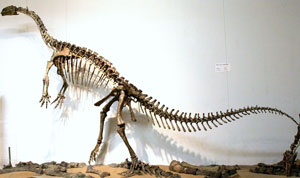
- Ornithischia (鳥盤類 < G of a bird) 白亜紀末絶滅
鳥類も含め恥骨が後向き
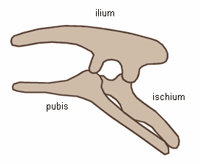
- Saurischia (竜盤類)
恥骨は前向き、但し鳥類は竜盤類から進化
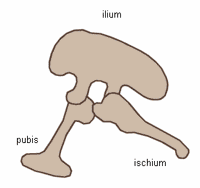
- Allosaurus: (異竜)
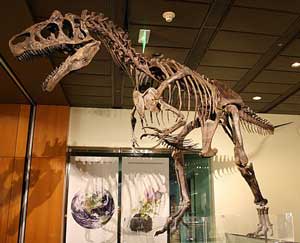
- 植物相の急激な変化:
- 恐竜は裸子植物の世界に生きた
- 裸子植物: 針葉樹・シダ・ソテツ・イチョウ
- 白亜紀初期:
- 花の咲く植物登場
- 被子植物は植生の90%に
- 植物の変化は動物にも影響
- ジュラ紀・白亜紀の恐竜の肺と鳥の進化
- Archaeopteryx (始祖鳥):

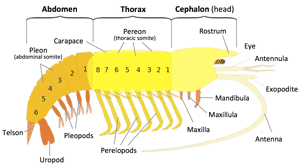
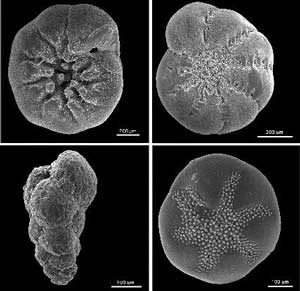
|
>Top 10. The Cretaceous extinction and the rise of large mammals:
- Extinction of the dinosaurs:
- a large asteroid (10km in diameter) smashed the Cretaceous world out of existence in a short-term reign of fire and toxicity.
- Dinosaurs were all dead, as were all ammonites rudistid clams, mosasaurs, and about 50% of rest of the species.
- by the end of Cretaceous, CO2 was still higher concentration than now, and O2 was still lower
- Ancestors of mammals:
- Paleozoic and early Mesozoic therapsids, and even through Triassic they maintained moderate diversity.
- The first true mammals are found in late Triassic - at about the time of the first dinosaurs; they have both appeared at the same time, but went on to very different fates.
- Size:
- The first dinosaurs were already relatively large animals for their time (about 1m), bun soon after they evolved into much larger sized.
- But the first mammals may have been a tenth in size, and then stayed small for a very long time.
- All Mesozoic mammals were small, until the latest Cretaceous.
- Reproduction of mammals:
- almost all mammals today are placental; the newborn is capable of existence outside the mother.
- a few are marsupial, where early birth required of time in a secondary poach within the mother.
- a very few, such as platypus and echidna, lay eggs.
- we have no record of mammal eggs; utterly opaque when the first placental mammals occurred.
- Competition with dinosaurs:
- Mammals did not compete with dinosaurs for ecological reasons.
- Perhaps in hot, low O2 world, a larger, warm-blooded, highly active mammal was just too energetically expensive to exit.
- Dinosaurs were a really different kind of beast than anything else, at least until Cretaceous, were the only kind of animal that worked really well in peculiar early and mid-Mesozoic conditions on Earth.
- Size after the Cretaceous extinction:
- the first size increase occurred in the first few million years after the Cretaceous extinction.
- Much larger increase in size happed much later, in 50-40 ma in Eocene Epoch.
- Probably, it was enabled by a rise in O2.
- Placental reproduction:
- Mother's arterial blood mixed with venous blood; fetal blood picks up its O2 load from this admixture, exposed to O2 levels that are lower than that of mother's arterial blood.
- No mammal reproduces above 4,000 m, which corresponds to O2 levels of early Jurassic.
- the placental system of reproduction was not possible until O2 blood levels had risen to Cretaceous levels (above 15% or approaching 20%)
- The rise of humans:
- the rise of high intelligence and culture; by the glaciation of the past 2m years; O2 level were higher than now, 28% in 5 ma.
- Nervous system tissue needs more oxygen than any other kind of tissue.
|
10. 白亜紀絶滅と大型哺乳類の興隆
- K/T (Cretceous-Paleogene boundary)
- 75%の種と99%の固体が絶滅
- 直径10kmの巨大隕石落下
- 衝突エネルギー108−109メガトン;米ソの核弾頭の1万倍
- Crator直径200km
- 闇が数ヶ月〜数年継続
- Magnitude 10の地震+高さ300mの巨大津波
- Ir濃集
- 衝突は6月; 蓮・睡蓮の化石から
- 恐竜・鳥盤類・アンモナイト絶滅
- Cenozoic Era (新生代):
| Quarter-nary |
Holocene |
0.0117-0 |
| Pleistocene |
2.58-0.0117 |
| Neogene |
Pliocene |
5.33-3.60 |
| Miocene |
23.03-5.33 |
| Paleogene |
Oligocene |
33.9-23.03 |
| Eocene |
56.0-33.9 |
| Paleocene |
66.0-56.0 |
| Cretaceous |
Late Cret. |
100.6-66.0 |
| Early Cret. |
145.0-100.5 |
|
>Top 11. Should we fear the oxygen future?
- Can O2 levels be expected to stay the same, or will they undergo wild swings as the past 540 m years.
- This century will continue to be a time of warming from greenhouse gases produced by humanity.
- 100 years from now the planet will have returned to its atmospheric condition during late Cretaceous through Eocene; happily those were times when O2 was bout its present level, or was even slightly higher.
- The fate of O2 is fixed by the rate at which organic compounds and sulfur-containing compounds and minerals (pyrite) are buried.
- Plate movement:
- 500 ma (the Cambrian Explosion), the continents were widely dispersed along the equator.
- For the next 200 m years, large-scale drift and continental collision resulted in the formation of ever-larger land bodies.
- By about 300 ma, the major continent had coalesced into a single united block, named Pangea.
- By about 200 ma, the huge continent began to break apart, creating Atlantic ocean.
- By 120 ma, the southern continents broke apart as well, with Africa, Antarctica, India, and Australia moving in divergent directions and culminating present positions.
- the next few million years:
- Atlantic Ocean will continue to widen, ant Pacific Ocean will to close.
- Loss of Mediterranean Sea.
- Australia will have moved northward.
- New seduction zones; in Indian Ocean and the ocean off Puerto Rico.
- Antarctica drifts northwards; its vast ice sheets will melt and the sea level will rise (90m than now).
- the sun continues to increase its energy output, causing temperatures to rise; all ices of Greenland and Antarctica melt.
- the most radical changes in O2 was; Carboniferous levels (30%) dropped in early Permian (10%) some 210 ma.
- Future work:
- We will have to revise our understanding of the whys in the history of life.
- If O2 has varied through time along the lines, it seems likely that organisms would adapt in varied ways to these different conditions.
- O2 is to be loved and hated - but also respected. Respiration has been the most important driver of evolution. Will it be a epitaph for our planet?
|
11. 酸素の未来についての危惧?:
- O2レベルの変動は
- 人間による温室効果
- 100年後は白亜紀後期〜始新世の頃
- 大陸移動
- 500ma; 大陸は赤道近辺に分散
- その2億年後、大規模な大陸移動
- 約300ma, パンゲア超大陸
- 200ma, 分裂により大西洋生成
- 今後数百万年
- 大西洋拡大
- 太平洋縮小
- 地中海消失
- インド洋、カリブ海沈降
- 南極の北方移動
- 太陽活動活発化
- グリーンランド・南極の氷氷解;海水面上昇90m
- 過去のO2濃度急変:
- 将来の研究課題:
- 生命の歴史のなぜに関する理解の修正
- O2レベル変化に伴う生命の対応
- O2は愛憎が極端。呼吸システムは進化にとって最重要。それは地球の墓誌でもある。
|
| Taxon |
Medium |
Type |
Absorption surface |
Surface area |
Blood flow |
Soure of pump |
Chambers
in heart |
Blood pigment |
| Humans |
Air |
Pump lung |
Complex alveoli 肺胞 |
High |
High |
Diaphragm breathing 横隔膜 |
Four |
Hemoglobin |
| Birds |
Air |
Pump lung with added air sac |
Sunoke akveiku ub kybgm & internal surface of air sacs |
High |
High |
Ribcage, pelvic 胸郭, 骨盤 |
Four |
Hemoglobin |
| Lizards |
Air |
Pump lung |
Simple alveoli |
Low |
Low |
Diaphragm |
Three |
Hemoglobin |
| Crocodiles |
Air |
Pump lung |
Simple alveoli |
Low |
Low |
Pelvic pump |
Three |
Hemoglobin |
| Saurischian dinosaurs 竜盤類 |
Air |
Pump lung with added air sac |
? |
? |
? |
Ribcage, pelvic |
Four |
? |
| Fish |
Water |
Counter current gills |
Gill surface |
|
Low |
Rib ventilation 肋骨 |
Two |
|
| Bivalve mollusks |
Water |
Medium pressure |
Pump gills |
|
Low |
Cilia in siphon 繊毛 |
One |
None |
| Chambered cephalopods 頭足類 |
Water |
Complex gills, high preesure pump gills |
Gill surface |
|
High |
Adductor muscle contraction 内転筋 |
One |
Hemocyanin |
| Brachiopods 腕足動物 |
Water |
Low pressure pump gills |
Lophophore surface, punctae (terebratulids) 総担 |
|
Low |
Cilia |
None |
None |
| Scleractinian corals イシサンゴ |
Water |
No gill epithelial adsorption 上皮 |
Epithelium, internal mesentaries 上皮, 腸間膜 |
|
None |
None |
None |
None |
| Echinoids ウニ |
Water |
External gill, adsorption, tube feet |
Gill surface |
|
Low |
Water vascular system 維管束 |
|
|
| Bryozoans コケムシ |
Water |
Lophophore 総担 |
Epitheial absorption 上皮 |
|
Low |
Cilia |
None |
None |
| Sponges |
Water |
No gills, medium pressure pump |
Choanocyte cell surface 襟細胞 |
|
None |
Cilia |
Flagellar beating 鞭毛 |
None |
| Tunicates 被嚢類 |
Water |
Internal gill, medium pressure pump |
Internal gill surface |
|
Low |
Cilia |
|
|
|
















